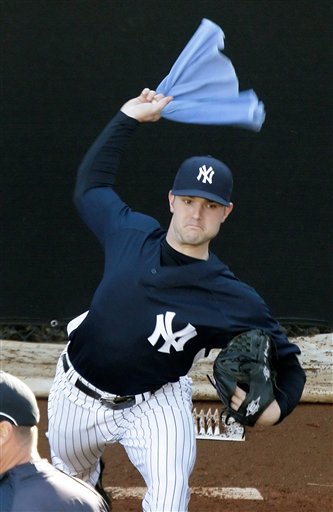 Ever since taking over as scouting director in 2005, Damon Oppenheimer has provided the Yankees with a steady stream of low cost pitching talent to plug holes in the bullpen and use as trade bait. Most of those arms have been acquired in the mid-to-late rounds of the draft, making those selections that much more rewarding. In 2006 he landed Mark Melancon (9th round), Dan McCutchen (13th), and David Robertson (17th), then in 2008 he drafted D.J. Mitchell (10th) and David Phelps (14th), and last year it was Sean Black (7th), Gavin Brooks (9th), and Graham Stoneburner (14th).
Ever since taking over as scouting director in 2005, Damon Oppenheimer has provided the Yankees with a steady stream of low cost pitching talent to plug holes in the bullpen and use as trade bait. Most of those arms have been acquired in the mid-to-late rounds of the draft, making those selections that much more rewarding. In 2006 he landed Mark Melancon (9th round), Dan McCutchen (13th), and David Robertson (17th), then in 2008 he drafted D.J. Mitchell (10th) and David Phelps (14th), and last year it was Sean Black (7th), Gavin Brooks (9th), and Graham Stoneburner (14th).
The general idea was to take polished college starters with good enough stuff, and hope pitching guru Nardi Contreras can take them to the next level. As more and more teams are becoming aggressive in the draft, it’s getting harder and harder to find valuable pieces after the 3rd or 4th or 5th round. Oppenheimer’s approach has yielded quality relievers and decent trade pieces, which is exactly what a big money club like the Yankees need.
Surely the Yankees will deploy the same strategy this June, using those usually fruitless middle rounds to replenish the pipeline with more useful arms that should climb the ladder quickly. Here’s a few such players the Yankees could target…
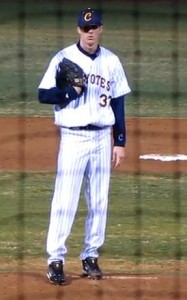 Bryan Harper, LHP, College of Southern Nevada
Bryan Harper, LHP, College of Southern Nevada
Projected top pick Bryce Harper isn’t the only baseball prospect in his family, his older brother Bryan is a pretty good player himself. After posting a 6.68 ERA with a 15-22 K/BB ratio in 32.1 IP as a freshman at Cal State Northridge, Harper transferred to CSN to help his brother transition to college ball when he should have been a junior in high school. He’s emerged as the Coyotes best starter, carving up the wood bat league to the tune of a 2.39 ERA with a 41-17 K/BB ratio in 26.1 IP.
A physical specimen like his brother, the elder Harper is projectable at 6-foot-5 and just 190 lbs. Obviously he needs to work on his command and control, but the raw stuff is there. His fastball generally sits 89-91 – less impressive than his brother’s heat, actually – and his second pitch is a big breaking curve that is a put-away pitch some days and a show-me offering on others. A changeup has been in the works as well. Harper needs to become more consistent with all of his pitches, and that will come with experience and pro instruction.
Draft eligible because of the transfer to a junior college, Harper is likely an early double-digit round selection. Teams with the top overall pick usually select that player’s bother if he’s draft eligible as a bit of a favor and also to provide a certain level of comfort. Most recently, the Rays drafted Jeremy Beckham in the 17th round after taking his younger brother Tim first overall in 2008. If the team that takes Bryce doesn’t draft Bryan later on, he’ll be a very tough sign and will likely end up following through on his commitment to South Carolina.
Photo Credit: Screen cap’d from here
Chris Hernandez, LHP, Miami
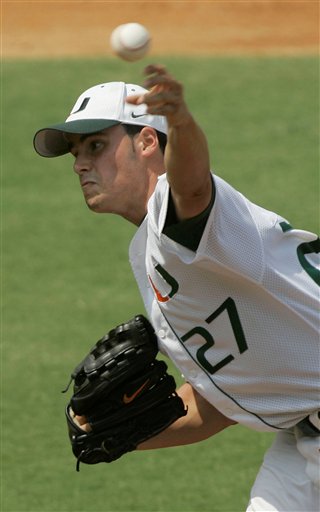 After turning the Tigers down out of high school as a 14th round pick in 2007, Hernandez became the early favorite to go 1-1 in 2010 after going 11-0 with a 2.72 ERA and an ungodly 117-18 K/BB ratio as a freshman. He took a step back in 2009, becoming much more hittable and doubling his walk rate. Hernandez has been better in four starts this year, posting a 27-7 K/BB ratio with a 2.35 ERA in 23 IP as the team’s Friday night starter.
After turning the Tigers down out of high school as a 14th round pick in 2007, Hernandez became the early favorite to go 1-1 in 2010 after going 11-0 with a 2.72 ERA and an ungodly 117-18 K/BB ratio as a freshman. He took a step back in 2009, becoming much more hittable and doubling his walk rate. Hernandez has been better in four starts this year, posting a 27-7 K/BB ratio with a 2.35 ERA in 23 IP as the team’s Friday night starter.
The 6-foot-1, 190 lb Hernandez features four quality pitches, led by a devastating cut fastball that sits 88-91. Once he learns to use the pitch in on righties, it’ll chew up wood bats. He also throws a straight four-seam fastball that tops out in the low-90’s, and his power slider has shown flashes of being a put-away pitch. Hernandez’s changeup is a solid offering that helps him neutralize righthanded batters. With above average control and decent command, Hernandez is aggressive in the strike zone but can fall victim to throwing too many strikes.
Hernandez is the ideal mid-round candidate, because he’s got good stuff, throws strikes, and has experience at a major college program. If he fills out just a little more and adds just a tick more to his fastball, everything is there for him to pitch near the front of a big league rotation. Expected to go somewhere in the 4th to 6th round range before the season, Hernandez will almost assuredly go higher than that if he keeps pitching as well as he has in the early going.
Photo Credit: Phil Coale, AP
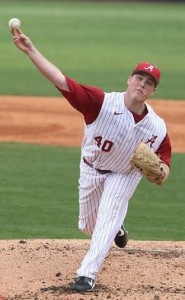 Jimmy Nelson, RHP, Alabama
Jimmy Nelson, RHP, Alabama
Hailing from David Robertson’s alma mater, Nelson isn’t even the best draft prospect on his own team, as he plays second (and third) fiddle to middle infielders Josh Rutledge and Ross Wilson. Used as a middle reliever and occasional spot starter during his first two years at Alabama, Nelson burst on the scene last summer after a dominant showing in the Florida Collegiate Summer League, when he lead the circuit with 75 strikeouts in 59 innings. He’s been able to carry that success into the spring, as he’s posted a 0.82 ERA with a 26-5 K/BB ratio in 22 IP covering four starts.
Nelson uses a pair of fastballs to set up his power slider, which is among the best in the draft class. His four-seam fastball will sit at 89-91, and he turn the ball over the get some sink with a two-seamer. The slider is Nelson’s bread and butter; he throws it in the low-80’s and uses it to get swings in misses almost at will. His control isn’t great but it is improving, and that’s really what’s holding him back from taking that step from good arm to great arm and top prospect.
With a big 6-foot-6, 235 lb pound, Nelson screams potential workhouse. He may not be able to start because he lacks the offspeed pitch to battle lefties, but with two fastballs and legitimate strikeout pitch, he projects as a quality power arm for the back of the bullpen. Nelson is expected to go anywhere from the 5th to 10th round at the moment, and the Yankees would hope that Contreras could help him polish off his control.
Photo Credit: Alex Gilbert, Alabama
Addison Reed, RHP, San Diego State
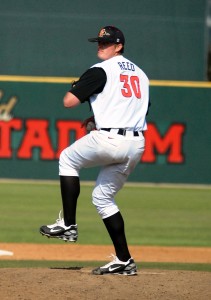 Reed had the unfortunate task of taking over as the Aztecs’ ace after some kid named Stephen Strasburg held it down for two years. While he hasn’t replaced Strasburg’s dominance, he’s pitched about as well as coach Tony Gwynn could have asked. After serving as the team’s closer as a sophomore, Reed has successful transitioned to the rotation and has a 2.36 ERA and a 30-7 K/BB ratio in 26.2 IP over four starts.
Reed had the unfortunate task of taking over as the Aztecs’ ace after some kid named Stephen Strasburg held it down for two years. While he hasn’t replaced Strasburg’s dominance, he’s pitched about as well as coach Tony Gwynn could have asked. After serving as the team’s closer as a sophomore, Reed has successful transitioned to the rotation and has a 2.36 ERA and a 30-7 K/BB ratio in 26.2 IP over four starts.
The 6-foot-3, 215 pounder has more of a classic reliever’s repertoire, consistently showing 94 with his fastball and the ability to spin a decent breaking ball. He’s very aggressive and willing to challenge hitters, which at times can get him in trouble with the long ball. The physical ability is there, now it’s just a matter of helping Reed develop that ability into baseball skills so he can reach his ceiling. Projected to go in the 3rd to 5th round, Reed will probably be the first of the four players in this post to have his named called on Draft Day.
Photo Credit: San Diego Hall of Champions
While all four of these pitchers have the potential to turn into useful big leaguers down the road, none of them are expected to be drafted in a premium round. The Yankees have done as good a job as anyone when it comes to evaluating pitching and developing into more than anticipated, giving them plenty of options to rotate in and out of the bullpen and to market to other teams in trades. Any of these four would continue that tradition.
David Robertson Photo Credit: Gene J. Puskar, AP
Leave a Reply
You must be logged in to post a comment.